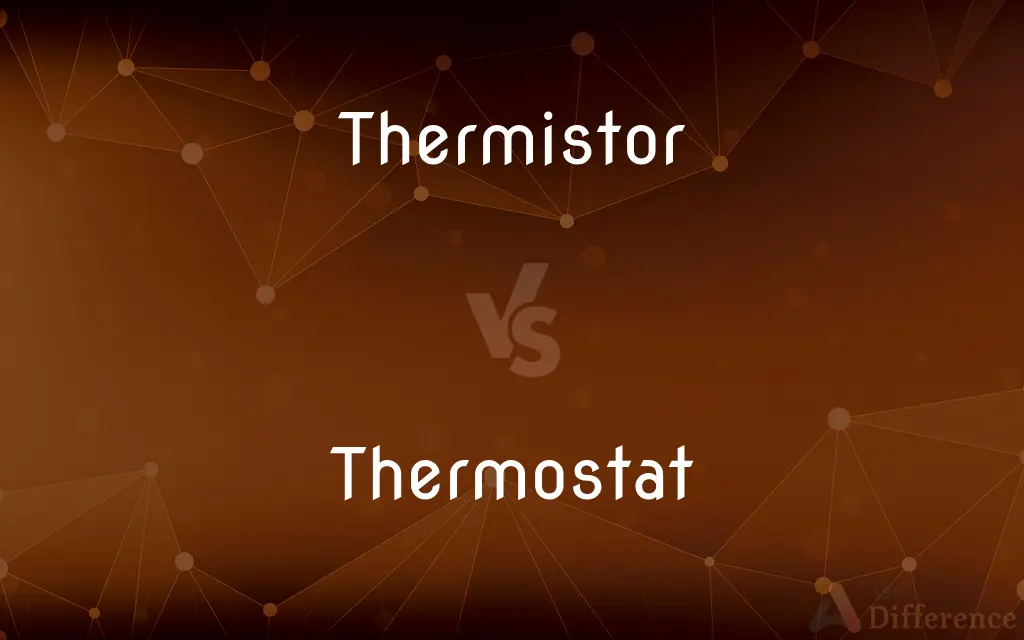Thermistor vs. Thermostat — What's the Difference?
By Urooj Arif & Maham Liaqat — Updated on March 1, 2024
A thermistor is a temperature-sensitive resistor whose resistance changes with temperature, while a thermostat is a device that controls heating or cooling systems to maintain a desired temperature.

Difference Between Thermistor and Thermostat
Table of Contents
ADVERTISEMENT
Key Differences
Thermistors are electrical components that change resistance with temperature changes, used for precise temperature measurements. Thermostats, on the other hand, are control devices that regulate the operation of heating or cooling systems based on the temperature settings input by users. While thermistors are key in sensing temperature changes, offering high sensitivity, thermostats utilize this information (or other temperature sensors) to maintain or alter environmental conditions according to pre-set preferences.
Thermistors come in two main types: Negative Temperature Coefficient (NTC), where resistance decreases with an increase in temperature, and Positive Temperature Coefficient (PTC), where resistance increases with temperature. Thermostats can be mechanical, employing bimetallic strips or gas-filled bellows, or digital, using electronic temperature sensors for more precise control.
The primary function of a thermistor is to provide data about temperature changes, making it crucial for systems requiring temperature monitoring. Thermostats, however, are designed to take action based on the temperature data, activating or deactivating heating and cooling systems to achieve a desired temperature level.
Thermistors are often found in electronic devices for temperature monitoring, such as in battery packs, chargers, and HVAC systems. Thermostats are predominantly used in residential and commercial spaces to manage the indoor climate, ensuring comfort and energy efficiency.
The choice between a thermistor and a thermostat depends on the need: thermistors for precise temperature measurement and monitoring, and thermostats for controlling the environmental temperature based on those measurements.
ADVERTISEMENT
Comparison Chart
Function
Measures temperature via resistance changes
Controls heating/cooling systems to maintain desired temperature
Types
NTC (resistance decreases with temperature), PTC (resistance increases with temperature)
Mechanical (uses bimetallic strips), Digital (uses electronic sensors)
Application
Temperature sensing in electronic devices
Regulating indoor climate in buildings
Sensitivity
High, provides precise temperature measurements
Depends on sensor type, aims for maintaining set temperature
Control Action
None, only measures temperature
Activates or deactivates systems based on temperature settings
Compare with Definitions
Thermistor
NTC thermistors decrease in resistance as temperature increases, useful for over-temperature protection.
An NTC thermistor protects a laptop battery by monitoring its temperature during charging.
Thermostat
A thermostat is a device that regulates the temperature of a system to a desired setpoint.
A home thermostat maintains comfortable living conditions by controlling the HVAC system.
Thermistor
PTC thermistors increase in resistance with rising temperature, serving as a self-regulating heating element.
A PTC thermistor in a car's seat heater prevents it from getting too hot.
Thermostat
Mechanical thermostats use bimetallic strips to control heating and cooling systems.
An old-school room thermostat uses a bimetallic strip to turn the furnace on or off.
Thermistor
They are widely used in electronic circuits for temperature compensation.
A thermistor compensates for temperature variations in a radio transmitter.
Thermostat
Thermostats are integral to achieving energy efficiency in heating and cooling systems.
Upgrading to a programmable thermostat can significantly reduce home energy bills.
Thermistor
A thermistor is a type of resistor whose resistance varies significantly with temperature.
In a coffee maker, a thermistor monitors the water temperature to prevent overheating.
Thermostat
Digital thermostats provide more precise temperature control using electronic sensors.
A digital thermostat can be programmed for different temperatures at different times of the day.
Thermistor
Thermistors are crucial in precision temperature measurement and control systems.
In medical devices, thermistors ensure fluids are at body temperature.
Thermostat
Smart thermostats learn from user behavior to optimize heating and cooling schedules.
A smart thermostat adjusts the temperature based on your daily routine, saving energy.
Thermistor
A thermistor is a type of resistor whose resistance is strongly dependent on temperature, more so than in standard resistors. The word is a combination of thermal and resistor.
Thermostat
A thermostat is a regulating device component which senses the temperature of a physical system and performs actions so that the system's temperature is maintained near a desired setpoint. Thermostats are used in any device or system that heats or cools to a setpoint temperature, examples include building heating, central heating, air conditioners, HVAC systems, water heaters, as well as kitchen equipment including ovens and refrigerators and medical and scientific incubators.
Thermistor
A resistor made of semiconductors having resistance that varies rapidly and predictably with temperature.
Thermostat
A device that automatically responds to changes in temperature by activating a heating or cooling system to maintain the temperature at a desired setting.
Thermistor
(electronics) A resistor whose resistance varies rapidly and predictably with temperature and as a result can be used to measure temperature.
Thermostat
A device that automatically regulates temperature, or that activates a device when the temperature reaches a certain point.
Thermistor
A semiconductor device made of materials whose resistance varies as a function of temperature; can be used to compensate for temperature variation in other components of a circuit
Thermostat
A device, as in a home heating system, a refrigerator, or an air conditioner, that automatically responds to temperature changes and activates switches controlling the equipment.
Thermostat
(physics) An algorithm used to maintain a simulated system at a set temperature by absorbing or releasing heat
Thermostat
A device which automatically regulates temperature, or provides a signal used by another device to regulate temperature. The temperature-sensitive signal may be electronic, as that produced by a thermocouple. The signal may also be caused mechanically, as by the unequal expansion of different metals, liquids, or gases by heat, which can then cause the opening or closing of the damper of a stove, or the like, as the heat becomes greater or less than is desired.
Common Curiosities
Can a thermostat work without a thermistor?
A thermostat can work without a thermistor but requires some type of temperature sensor to function properly.
Why are thermistors important in electronics?
Thermistors are important in electronics for precise temperature monitoring, which is crucial for the safety and efficiency of devices.
How does a thermostat work?
A thermostat works by activating or deactivating heating and cooling systems to maintain a set temperature.
What is the main function of a thermistor?
The main function of a thermistor is to measure temperature through resistance changes.
Is a thermistor used for temperature control?
A thermistor itself does not control temperature; it measures temperature changes for monitoring or input to control systems.
What are NTC and PTC thermistors?
NTC thermistors decrease in resistance with an increase in temperature, while PTC thermistors increase in resistance as temperature rises.
What makes smart thermostats different?
Smart thermostats learn from user behavior to automatically adjust heating and cooling for efficiency and comfort.
How accurate are thermistors?
Thermistors are highly accurate for temperature measurements, with precision dependent on the specific type and application.
How do I choose between a thermistor and a thermostat?
Choose based on your need: a thermistor for temperature measurement and a thermostat for temperature control.
Are thermistors and thermostats interchangeable?
No, they are not interchangeable due to their different roles in temperature measurement and control.
What types of thermostats are there?
There are mechanical and digital thermostats, including programmable and smart thermostats.
Can I replace a thermistor with a thermostat?
No, because they serve different functions: one for measuring temperature and the other for controlling temperature.
What is the role of a thermistor in a thermostat?
In some systems, a thermistor acts as the temperature sensing component within a thermostat.
How do digital thermostats measure temperature?
Digital thermostats often use electronic sensors, including thermistors, for precise temperature measurement.
Why would I need a thermistor in an HVAC system?
A thermistor in an HVAC system provides accurate temperature readings for the thermostat to maintain the desired climate.
Share Your Discovery

Previous Comparison
Objective vs. Unobjective
Next Comparison
Intraoperative vs. PerioperativeAuthor Spotlight
Written by
Urooj ArifUrooj is a skilled content writer at Ask Difference, known for her exceptional ability to simplify complex topics into engaging and informative content. With a passion for research and a flair for clear, concise writing, she consistently delivers articles that resonate with our diverse audience.
Co-written by
Maham Liaqat















































